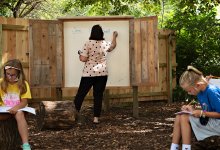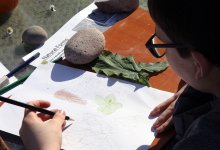Place-Based Learning
Location, location, location! See what happens when schoolwork explores students’ connections with local history, environment, culture, or economy.
Exploring Campus With an Environmental Lens
When freshmen take a science course that immerses them in their school’s culture and physical space, they develop a sense of belonging—and a deep connection to the mission.Ramping Up Relevance With Community-Centered Learning
Community-based research projects can help upper elementary and middle school students see value in what they’re learning.138Your content has been saved!
Go to My Saved Content.With Safety in Mind, Schools Take Classes Outdoors
There are plenty of logistics to consider, but educators say outdoor classes keep kids and teachers safer—and provide much-needed fresh air.12.9kYour content has been saved!
Go to My Saved Content.How to Make the Most of Loose Parts Play in Preschool
From counting and classifying to literacy lessons, teacher-tested learning opportunities that encourage autonomy and creativity.How Outdoor Education Can Shift Mindsets in the Classroom
This school leverages lessons from their on-campus ropes course to help students realize their full potential as part of a community of learners—and beyond.Using Nature to Introduce Math in Preschool
Young children can learn about math concepts through activities rooted in exploring the outdoors.Using Local Place Names to Teach History
These place-based learning ideas help high school students discover more about their community as they learn to use the historical method.Teaching Teens How to Separate Fact From Fiction
When students study their region’s scariest urban legends, they learn about oral history—and how to look for kernels of truth from the past.4 Ideas for Connecting to Nature in Elementary Classrooms
Bringing nature into every subject not only is beneficial to student wellness and learning, but also can make curriculum more relatable and engaging.Using Place-Based Learning to Spark Inquiry
Projects like mapmaking can ignite students’ curiosity and help them connect with their communities.321Your content has been saved!
Go to My Saved Content.What Students Can Learn From Studying Urban Legends
Lessons on urban legends can teach high school students a lot about their community and about historical thinking processes.Using Origami to Teach Children About Endangered Animals
As elementary students turn squares of paper into animals they’re studying, the age-old Japanese art form makes lessons more memorable.1.2kYour content has been saved!
Go to My Saved Content.Increasing the Flow of Understanding: Place-Based Learning With Rivers
Teachers of every content area can introduce place-based learning that encourage students to understand the vital importance of rivers in multiple contexts.210Your content has been saved!
Go to My Saved Content.Teaching Physics With a Real-World Context
Placed-based learning provides a way for high school students to directly engage with scientific phenomena in their daily lives.Simple Ways to Bring Learning Outside
Going outside helps students focus, and activities for classes from social studies to math can incorporate the natural world.1.3kYour content has been saved!
Go to My Saved Content.














